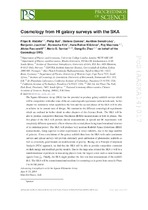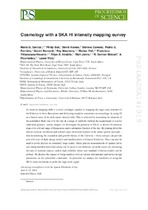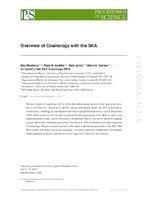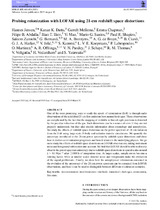Browsing Faculty of Natural Sciences by Author "Abdalla, Filipe B."
Now showing items 1-4 of 4
-
Cosmology from HI galaxy surveys with the SKA
Maartens, Roy; Abdalla, Filipe B.; Bull, Philip; Camera, Stefano; Benoit-Levy, Aurelien; Joachimi, Benjamin; Kirk, Donnacha; Klöckner, Hans-Rainer; Raccanelli, Alvise; Santos, Mario G.; Zhao, Gong-Bo (Proceedings of Science, 2014)The Square Kilometer Array (SKA) has the potential to produce galaxy redshift surveys which will be competitive with other state of the art cosmological experiments in the next decade. In this chapter we summarise what ... -
Cosmology with a SKA HI intensity mapping survey
Santos, Mario G.; Bull, Philip; Alonso, David; Camera, Stefano; Ferreira, Pedro G.; Bernardi, Gianni; Maartens, Roy; Viel, Matteo; Villaescusa-Navarro, Francisco; Abdalla, Filipe B.; Jarvis, Matt; Metcalf, R. Benton; Pourtsidou, A.; Wolz, Laura (Proceedings of Science, 2014)HI intensity mapping (IM) is a novel technique capable of mapping the large-scale structure of the Universe in three dimensions and delivering exquisite constraints on cosmology, by using HI as a biased tracer of the ... -
Overview of Cosmology with the SKA
Maartens, Roy; Abdalla, Filipe B.; Jarvis, Matt; Santos, Mario G. (Proceedings of Science, 2014)The new frontier of cosmology will be led by three-dimensional surveys of the large-scale structure of the Universe. Based on its all-sky surveys and redshift depth, the SKA is destined to revolutionize cosmology, in ... -
Probing reionization with LOFAR (Low Frequency Array) using 21-cm redshift space distortions
Jensen, Hannes; Datta, Kanan K.; Santos, Mario G.; Mellema, Garrelt; Chapman, Emma; Abdalla, Filipe B.; Iliev, Ilian T.; Mao, Yi; Shapiro, Paul R.; Zaroubi, Saleem; Bernardi, Gianni; Brentjens, M. A.; de Bruyn, A. G.; Ciardi, B.; Harker, G. J. A.; Jelić, V.; Kazemi, S.; Koopmans, L. V. E.; Labropoulos, P.; Martinez, O.; Offringa, A. R.; Pandey, V. N.; Schaye, J.; Thomas, R. M.; Veligatla, V.; Vedantham, H.; Yatawatta, S. (Oxford University Press, 2013)One of the most promising ways to study the epoch of reionization (EoR) is through radio observations of the redshifted 21-cm line emission from neutral hydrogen. These observations are complicated by the fact that the ...




